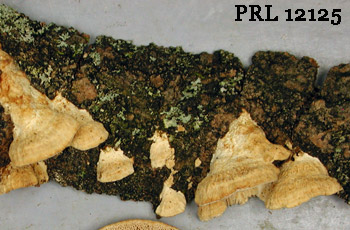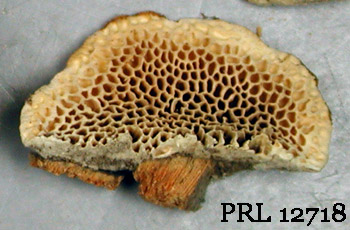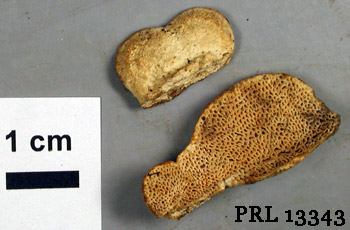Antrodia
favescens



Antrodia favescens
[Polyporus favescens, Trametes sepium]
- Name
- none
- Etymology
- Epithet = becoming honeycomb. Genus = cavelike?
- Fruitbody
- Brackets sessile on vertical wood surface or may develop effused lower part, otherwise can be effused-reflexed to fully resupinate. Brackets semi-circular, not usually fusing together, covering a few square cm. Upper surface uneven, with obscure pale brown zones. Pore surface cream to pale brown. Pores angular to becoming slightly elongated, generally 13 to 18 per cm (1 - 2 per mm), with thin entire or serrate walls. Spores 6.3–10.3 × 2.7–4.3 µm.
- Similar species
- Truncospora ohiensis (Perenniporia) has hoof-shaped brackets with smaller round pores. The other Antrodia species are much more effused and caps are more fused together.
- Ecology
- Brown rot of hardwoods and conifers. Often on wooden fences.
- Phenology
- September to October for Chicago Region.
- Biogeography
- Widely distributed in North America according to Spirin et al. (2013) though they give no list of collections with locations. Mapping this taxon is uncertain with online resources because of its tangled history with other species. Several collections were identified at the NAMA 2013 foray Arkansas, NAMA 2015 North Carolina, and NAMA 2016 Virginia.
- Chicago Region status
- Rare. One historic record found for Trametes sepium: C. B. Stifler, Evanston, on post fence (BPI 245433). Presumably the same person as M. C. B. Stifler who collected 1927 to 1943 (25% of his collections lack a date). Older collections will need be be checked. Several 2014 collections appear to be this species but the pores are a bit small at 20 to 23 per cm. The 2015 collection in Kane County has 15 to 19 pores per cm (PRL 12718).
- Specimens examined
- PRL 12125, PRL 12718; possibly PRL 13343.
Taxon Details and Links
- Nomenclature
-
- Antrodia favescens , Mycologia 105 (2): 1564 (2013)
- ≡ Basionym: Polyporus favescens , Transactions of the American Philosophical Society 4 (2): 158 (1832)
- ≡ Poria favescens , Grevillea 14 (72): 113 (1886)
- = Polyporus rhododendri , Transactions of the American Philosophical Society 4 (2): 158 (1832)
- =
Trametes
sepium
,
London Journal of Botany 6: 322 (1847)
- ≡ Coriolellus sepium , Bulletin of the Torrey Botanical Club 32 (9): 481 (1905)
- = Trametes minima , Mycol. Writ.: 850 (1919) [fide Murrill 1920. Mycologia 12(1): 8.]
- Type
- Lectotype. USA Pennsylvania: Bethlehem, on branch, Schweinitz, (PH; lectotypification by Overholtz 1923).
- Taxonomy
- See the Spirin et al. 2013 description link below for details on the history of this taxon in connection with Trametes sepium. An additional note is that Gilbertson and Ryvarden (1986) listed Trametes sepium and Daedalea serpens as synonyms of Antrodia albida. Spirin et al. (2013) treat T. sepium as a synonym of A. favescens, D. serpens as a separate Antrodia species, and A. albida as a synonym of Antrodia heteromorpha.
- Description links
- MycoBank: Description from Spirin et al. 2013.
- Related links
- Google Books: Note by C. G. Lloyd 1919.
- Spirin, Vlasák, Niemelä, and Miettinen. 2013. What is Antrodia sensu stricto? Mycologia 105(6): 1555-1576. DOI: 10.3852/13-039
- Records online
- iNaturalist
- Mushroom Observer
- MycoPortal (synonyms not linked): Antrodia favescens, Polyporus favescens, Trametes sepium [But ignore A. albida records.]
- Taxon links
- 803296 Antrodia favescens
- MycoBank
- Index Fungorum and Species Fungorum
- Note: The synonymy on Index Fungorum and Mycobank has not been updated to reflect this new work.